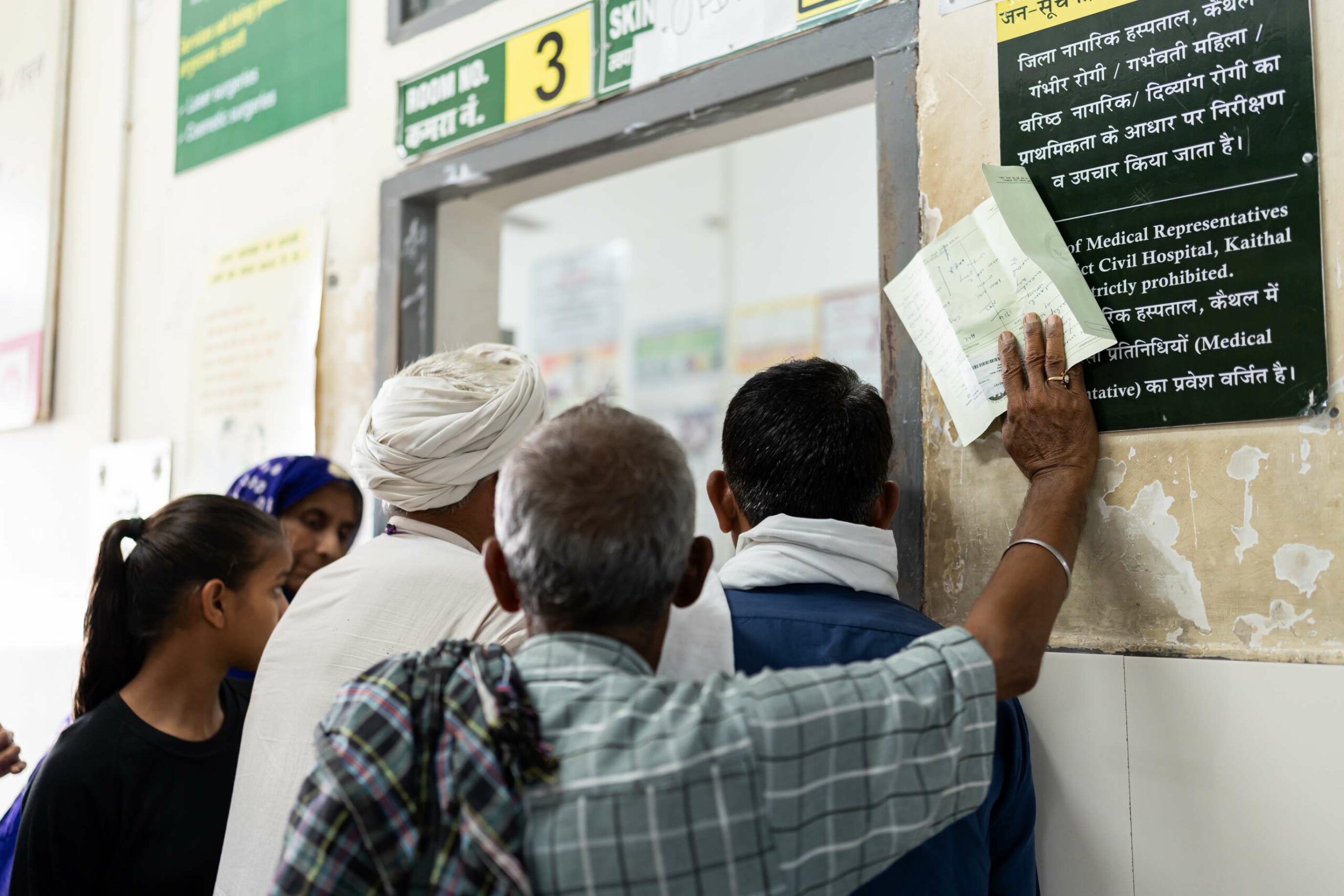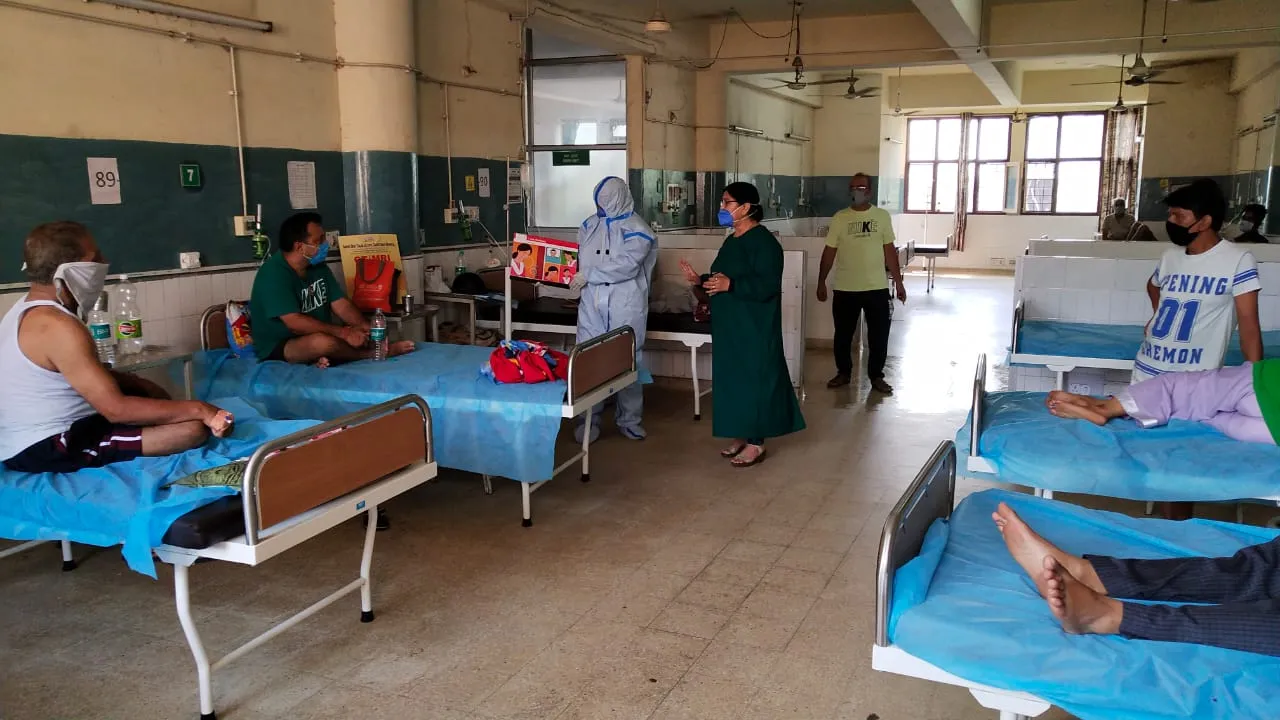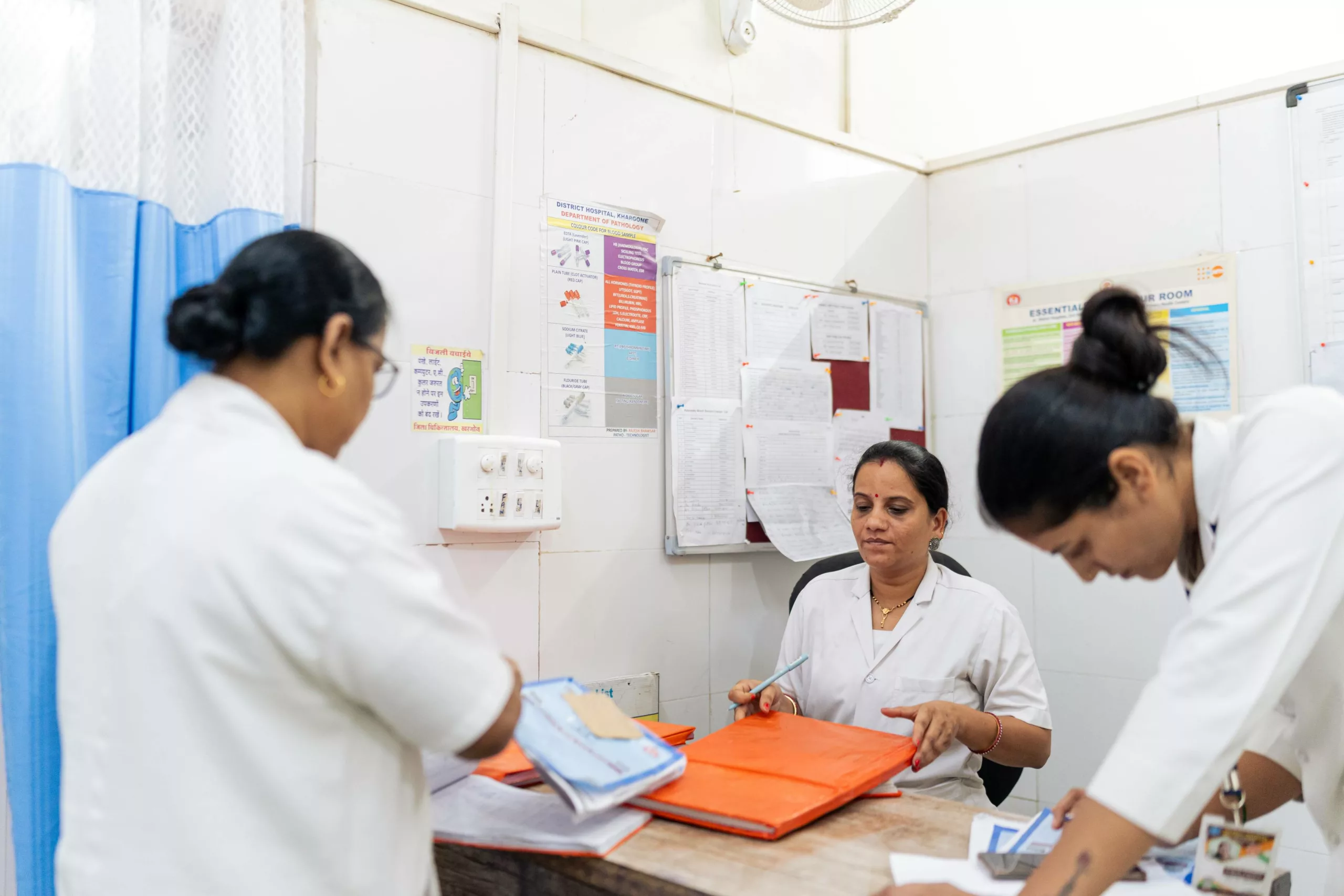
How do nurses in India spend their time?
Insights from a time-motion study.
Every morning, Nurse Kalpana walks through the doors of a hospital in a small town in Punjab, ready to embark on another day of caring. Her day begins in the maternity ward, where she tends to the needs of her patients. She administers medicines, conducts check-ups, and ensures that both mothers and babies are doing well. As the day unfolds, Kalpana’s work picks up pace. She finds herself juggling multiple administrative tasks — from maintaining medicine inventory to documenting patient information in meticulous detail. Each record she creates tells a story of resilience and hope, capturing the journey of life that passes through the ward’s doors.
Communication is a vital lifeline in Kalpana’s daily routine. She exchanges information with doctors, fellow nurses, and most importantly, her patients. Whether providing counseling during check-ups or teaching mothers about the benefits of breastfeeding, Kalpana’s words are a source of comfort and guidance.
Amidst the whirlwind of her demanding schedule, she finds windows of respite — an inside joke exchanged with a fellow nurse, or a quick break to call her son. These moments are fleeting, but essential, allowing her to return to her duties with renewed strength and dedication.
At the end of the day, as she prepares to leave the hospital, Kalpana reflects on her work. From the joy of bringing new life into the world to the emotional exhaustion that comes when caring, she knows that being a nurse is more than just a job — it’s a calling.
Nurse Kalpana represents countless healthcare workers whose dedication and tireless efforts shape the fabric of the Indian healthcare system. At 30.5 percent of the country’s total health workforce, nurses play a vital role in caring for patients.
Nursing time, satisfaction, and high-quality care
Central to high-quality patient care and nurse satisfaction is the time nurses spend directly interacting with patients. Qualitative studies show that healthcare workers derive satisfaction from the time spent on clinical work, direct interaction with patients, or on activities that indirectly impact patient care. Conversely, dissatisfaction arises from perceived issues such as ‘excessive paperwork’ and ‘wasted time’. A growing evidence base establishes a positive correlation between higher nursing time per patient per day and improved patient outcomes.
Given that the time nurses invest in patient interactions correlates directly with the quality of care they provide and patient well-being, it is crucial to understand how to keep it at the core of their work. The first step in this process is understanding how nurses currently spend their time. This involves identifying the diverse activities undertaken by nurses in a day, with specific details about the time and frequency of tasks. By comprehensively understanding how healthcare workers allocate their time, we can identify areas where tasks may be optimized or streamlined to enhance satisfaction, efficiency, and effectiveness in patient care delivery.
Inside the day in the life of a nurse
To gain insight into the daily realities of healthcare workers like Kalpana, in November 2023, we designed a time and motion study to understand how nurses allocate time to and prioritize various nursing activities during work shifts. Using this data, we hope to fill our knowledge gaps and further tailor our programs to nurses’ everyday needs and realities, ultimately leading to better outcomes for patients.
Participants were 16 healthcare workers from maternity wards across four Indian states — Punjab, Madhya Pradesh, Maharashtra, and Karnataka — who had been involved with Noora Health’s Care Companion Program (CCP) for at least six months.
The nurses received a calendar sheet to document the tasks and activities that they perform in a week, along with the time dedicated to each task. Using this sheet, nurses categorized their activities as primary, secondary, or tertiary, based on how important they felt the task was to patient care.
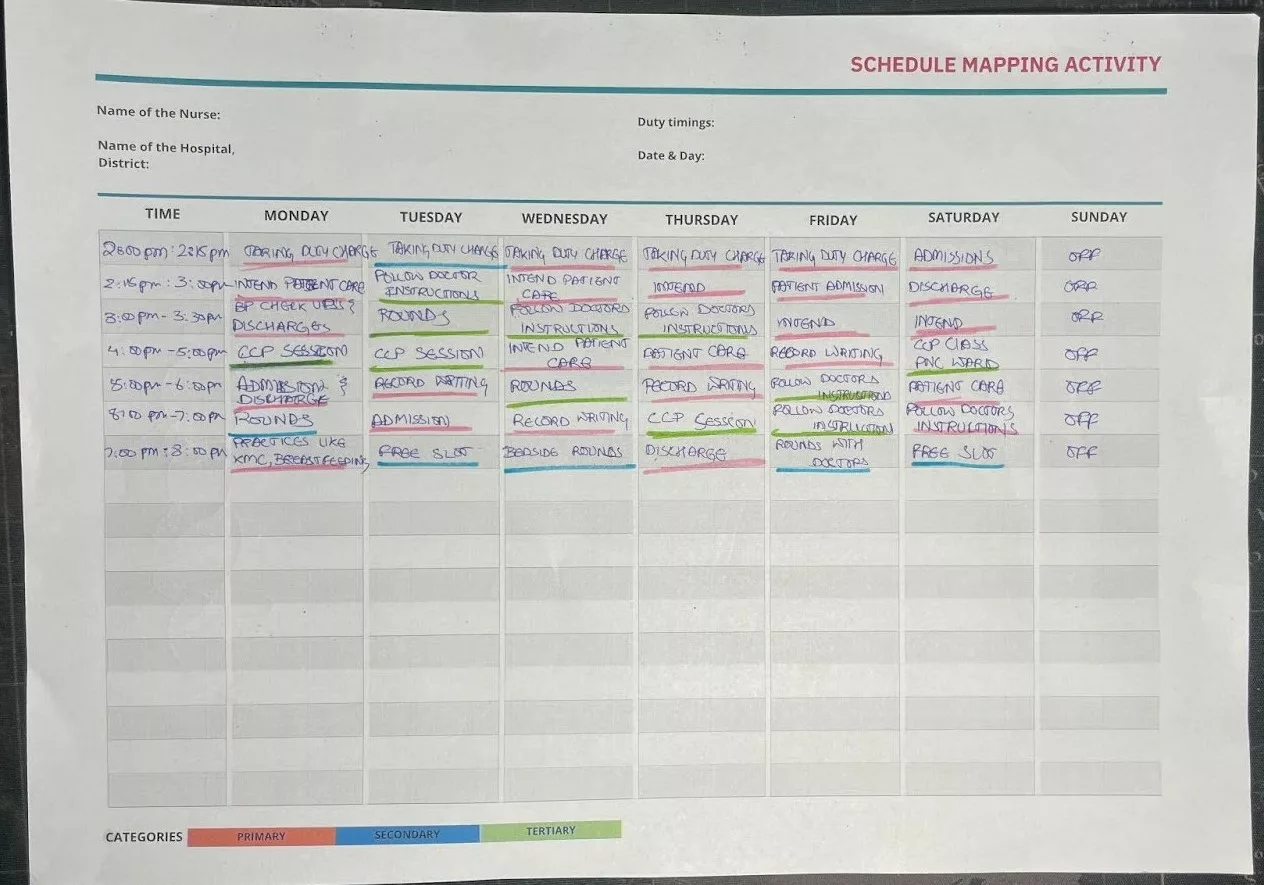
One caveat to our findings is that all responses are self-reported, which comes with a risk of participants sharing socially desirable responses, that is, they might unintentionally exaggerate their engagement in certain activities. Additionally, there is also a need to factor in the Hawthorne effect, a phenomenon where participants modify their behavior due to awareness of being observed. Despite these limitations, this study maps where healthcare workers in tertiary centers allocate their time and can play an important role in identifying areas where workflow improvement or resource reallocation could enhance efficiency and reduce unnecessary burden on staff.
Where do nurses actually spend their time?
In total, our study examined 801 hours of activity, spanning 77 workdays, across the 16 healthcare workers. Based on the activities observed, they were categorized into five distinct areas:
1. Direct nursing
Direct nursing tasks, which involve personally assisting patients and their families with medical treatments, assessments, and support, emerged as the most time-intensive category. It consumed a significant 39.6 percent of nurses’ time, translating to approximately 15 hours spent by a nurse in a week.
The reason for the high time allocation to direct nursing activities is likely because of the fundamental importance of hands-on patient care in healthcare delivery, which is essential for promoting patient well-being and recovery. Nurses’ perception of these tasks as a primary activity that is part of their core roles and responsibilities clearly indicates its important role in patient care.
In light of our findings and complementary research, it’s imperative to prioritize support and resources that streamline direct nursing tasks and ensure nurses have the necessary time and capacity to fulfill their hands-on patient care responsibilities effectively. This may entail optimizing staffing levels, providing additional training and tools, or implementing systems or technologies that reduce administrative burdens, allowing nurses to focus more on patient interactions.
2. Indirect nursing
Despite their crucial role in supporting patient health and well-being, indirect nursing tasks, which encompass everything from inventory management to facility hygiene and maintenance, accounted for only 5 percent of nurses’ time. The 16 healthcare workers collectively dedicated only around 30 hours per week, translating to approximately a little under two hours per person weekly. Nurses saw these tasks from a mixed perspective, where activities like maintaining inventory and facility hygiene and maintenance were categorized as both primary and secondary.
Our study also diverged from the findings of other studies globally, indicating a relatively higher time allocation to these tasks. One possible reason for this discrepancy between the importance of indirect nursing tasks and the limited time allocated to them could be the higher sense of urgency and immediacy associated with other activities. Limited resources — such as time constraints or staffing shortages — may force nurses to prioritize tasks considered more critical to patient care delivery, leading to indirect nursing tasks being deprioritized or overlooked.
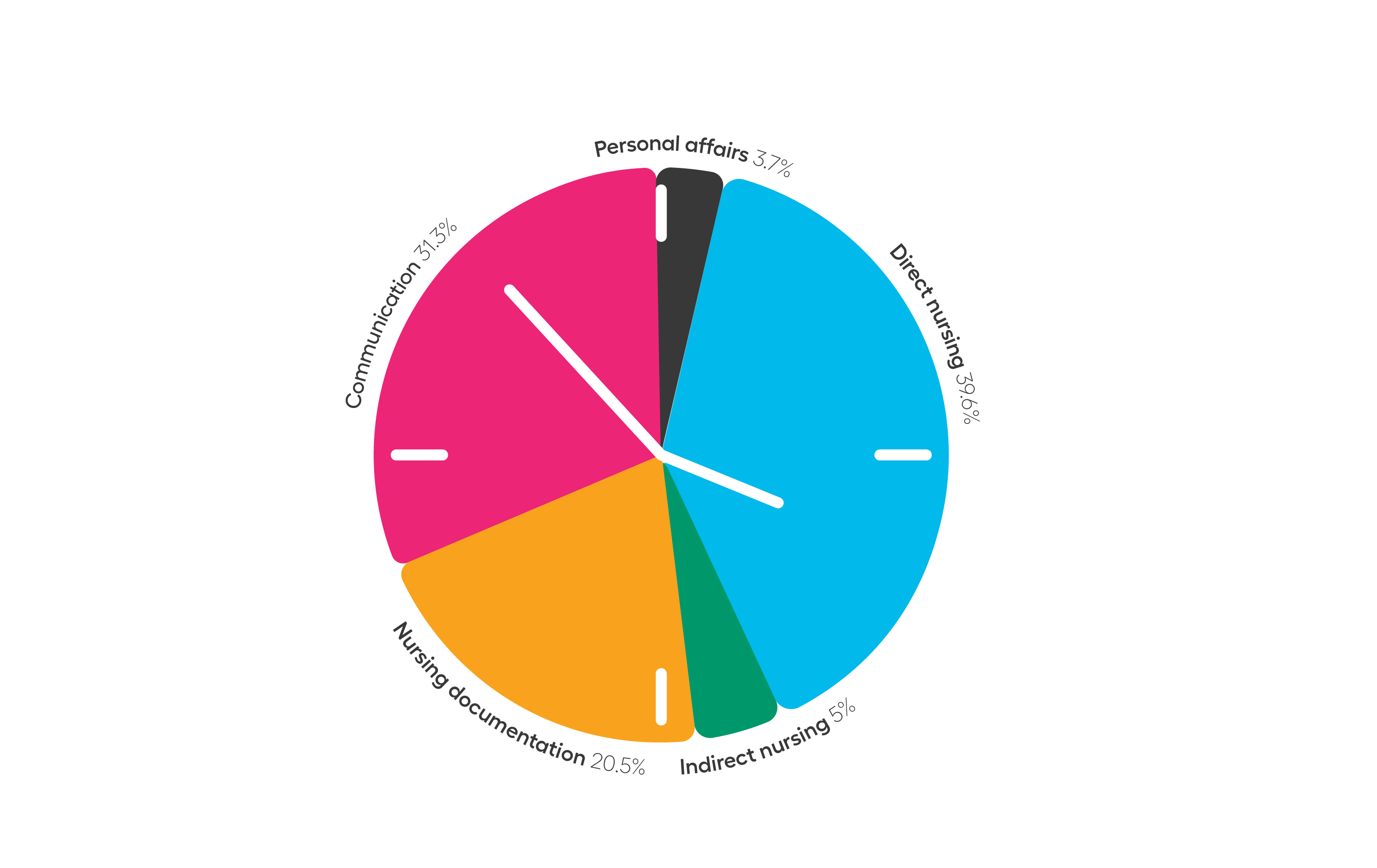
3. Communication
Communication, which forms the bedrock of most nursing work, was the second-highest area where healthcare workers spent time daily. It took up 31.3 percent of their time per week, totaling a little under 12 hours spent per nurse on average.
- The communication umbrella included three key areas:
Doctor–nurse communication, which involves activities like rounds of wards and meetings with hospital staff - Nurse–nurse communication, which is essential for collaborative work, shift handovers, and learning from each other about different health education programs
- Nurse-patient communication, which involves various activities like counseling sessions; bedside counseling; counseling for mothers and their family members; health talks; practices like kangaroo mother care, breastfeeding, and immunization; and facilitation of other health education programs like Noora Health’s Care Companion Program, and Family-Participatory Care.
Nurses classified different communication activities across the primary, secondary, and tertiary categories, suggesting that there’s no one uniform way the nurses feel about the relationship between communication and patient care.
Given the mixed nature of these findings, more research is needed to identify which specific communication tasks are perceived as the most impactful in enhancing patient care. Using these insights, healthcare organizations can tailor training programs and allocate resources more effectively to optimize communication practices.
4. Nursing documentation
Nurses spent 20.5 percent of their time daily recording and maintaining patient care information, completing admission and discharge procedures, and other documentation, amounting to approximately 6 hours a week per nurse. Thorough documentation is critical to ensuring continuity of care among healthcare teams, and supporting informed decision-making. However, when taken to the extreme, lengthy and time-consuming documentation is widely considered a barrier for healthcare staff to perform other essential tasks efficiently.
Reflecting this nuance, the 16 healthcare workers perceived various documentation activities belonging to all three categories. For instance, discharge and admission work was categorized as a primary activity, whereas other documentation work like maintaining records, case sheets, and documenting patient and case histories, was categorized in all three categories.
One way to optimize the documentation process without compromising on the quality and comprehensiveness of the records is to implement electronic health record systems or digital documentation platforms. By leveraging technology to streamline documentation workflows, healthcare organizations can alleviate the administrative burden on nurses, allowing them to allocate more time and focus on direct patient care activities, enhancing overall nurse satisfaction and patient outcomes.
5. Personal affairs
A minor fraction of nurses’ time — approximately 3.7 percent or 1.3 hours a week — was dedicated to breaks and free slots during work shifts. These moments of respite are crucial for recharging energy and maintaining well-being amidst demanding schedules.
Most nurses categorized these breaks as secondary or tertiary activities, which is a direct reflection of the priority given to other tasks in their weekly schedules. With activities like communication and documentation taking up big chunks of time, nurses may perceive their breaks as less important for high-quality patient care. However, it is essential to recognize the importance of these breaks in preventing burnout and maintaining overall job satisfaction among healthcare workers. By acknowledging the significance of relaxation periods and promoting a culture that values work-life balance, healthcare organizations can better support the holistic well-being of their nursing staff.
Tailoring programs to nurses’ needs
Our findings underscore the critical role that hands-on care tasks play in promoting patient well-being and recovery, and the need for this to continue being at the core of nurses’ responsibilities.
However, the limited time allocated to indirect nursing tasks raises concerns about resource allocation and the potential impact on patient safety and care quality. Communication emerged as another significant aspect of nursing work, highlighting the importance of effective interprofessional and patient communication in facilitating care delivery and promoting positive health outcomes. Furthermore, documentation, while essential for ensuring continuity of care and supporting informed decision-making, poses challenges when it consumes excessive time, potentially impeding nurses’ ability to focus on direct patient care. Lastly, the minimal time allocated to personal affairs surfaces the demanding nature of nursing work and the need for organizations to prioritize strategies that support nurses’ well-being and prevent burnout.
At Noora Health, we’re using these insights to bring about more alignment between our programs and nurses’ workflows and needs. For example, we’re making adjustments to monitoring and reporting components of the CCP to reduce the data collection burden as much as possible. Where possible, we aim to integrate into existing government monitoring systems as we have done in Andhra Pradesh and Punjab. In aligning our program with the realities of nurses’ work environments, we can enhance their job satisfaction, ability to deliver quality care and achieve better outcomes for patients.
For other organizations working with nurses, acting on these insights will help build a collaborative and supportive work culture that would empower nurses to fulfill their roles effectively while maintaining their motivation and well-being. Ultimately, by valuing nurses’ time and priorities, health systems can create an environment that not only meets the needs of patients but also nurtures the professional growth and fulfillment of those who care for others.

